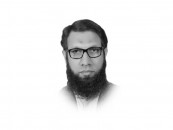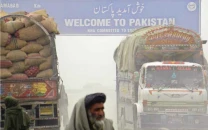Neglecting our most powerful weapon
There is an urgent need to focus on girls’ education in Pakistan, particularly in areas like Balochistan, Fata, etc

The writer is a child rights activist and development practitioner with a Master’s in Human Rights from the London School of Economics. He tweets @amahmood72
— Nelson Mandela
Education has never been a priority for successive governments in Pakistan and that’s why we are a nation with the second highest number of out-of-school children in the world after Nigeria. Scores of national and international reports launched, one after the other, keep highlighting the worsening state of education in the country, the latest being that of Alif Ailaan and the Sustainable Development Policy Institute’s (SDPI) “Pakistan District Education Ranking 2016”. If we have to improve the state of affairs in this country, one of the key areas of focus should be a serious emphasis on education. Countries like Brazil have shown that a country can improve its economic and political standing in the international community by prioritising and investing in education.
As has been highlighted in various surveys and reports in recent times, including the one by Alif Ailaan and the SDPI, Islamabad, Punjab, Azad Jammu and Kashmir and Khyber-Pakhtunkhwa (K-P) all have relatively better scores on education and infrastructure indices. However, Fata, Balochistan and Sindh are consistently poor performers, relative to the rest of the country. The top 22 districts all belong to Punjab, with K-P breaking in at the 23rd rank with Mardan. The latest district rankings show that Lahore slipped from the number three position in 2015 to 22nd in 2016. This is a city from which Prime Minister Nawaz Sharif has been elected seven times. It is quite clear that there is a need for a sustained focus on education even in mega cities like Lahore. Similarly, Quetta slipped from number 45 in 2015 to number 59 in 2016.
What is encouraging is that K-P has demonstrated improvements in both enrolment and gender parity scores. However, the retention rate of the province declined, consequently affecting its overall education score. Nevertheless, there have been substantial improvements in school infrastructure in the province, highlighted by its third rank in this area. There is still room for improvement though as 50 per cent of its schools still lack the provision of all basic facilities. Balochistan and Sindh continue to suffer from the lowest education and infrastructure scores. Balochistan’s education score has dropped, moving it to the last rank, and except for Quetta (which is amongst the top 50), almost half the districts of the province rank outside the top 100.
The quality of education imparted in the country remains the biggest challenge, as there are only moderate improvements in the score of learning outcomes as evidenced by the Alif Ailaan report. The evidence from Islamabad, Punjab and K-P demonstrates that strong political commitment can translate into improved education outcomes. The overall evidence from across the country, however, remains troublesome and suggests that Pakistan will need dramatically more political commitment to secure a decent future for its children. Balochistan is at number eight in the provincial and national education scores, even below Fata which is a matter of serious concern. The majority of districts of Balochistan rank outside the top 100 (27 out of 32) whereas eight of the bottom 10 districts are from the province. Only eight of the 31 ranked districts in the province scored above 50 on the education score. These statistics are an eye-opener for the PML-N and its allies in government in Balochistan. They should be more than enough to shake them up to focus on improving the state of education in the province. Balochistan was the second province after Sindh that introduced the Right to Free and Compulsory Education Act in 2014, however, it is clear that passing legislation alone does not necessarily translate into political will for implementing it and making budgetary allocations for the sector. K-P also remains below the national average, with a slightly reduced education score. Unlike in Punjab, K-P’s districts are more evenly distributed whereby one specific region does not dominate the rest, as was the case in previous years.
The goal of the federal and provincial governments has to be to achieve the aims related to education highlighted in the Sustainable Development Goals (SDG). Without an urgent effort by the governments to first collect and collate, and then act on the data for the education-related SDG targets, Pakistan will fail to deliver the SDGs, as it failed to deliver the Millennium Development Goals (MDG). Learning a lesson from the MDGs, it’s important that the process for implementation and monitoring progress of improvements is initiated immediately involving the provinces. Pakistan missed the gender parity target for 2005 under the MDGs and even today in 2016 we’ve not been able to achieve gender parity in education. The high dropout rates for girls is also resulting in their early marriages. There is an urgent need to focus on girls’ education in Pakistan, particularly in areas like Balochistan, Fata, K-P, southern Punjab and Sindh. Implementation of Article 25-A must be prioritised and a monitoring system put in place to ensure that all children between five to 16 years of age attend school. Teacher absenteeism also requires to be checked on a sustainable basis and the biometric time and attendance system should be put in place. Parent-Teacher Councils and other relevant forums should be involved in the monitoring of schools, teachers and students’ performance.
If one reads the foreword to the Alif Ailaan report written by Mosharraf Zaidi, the organistaion’s campaigns director, he states that “the government has given indication that it is listening. In February 2016, for the first-time ever, official government data on out-of-school children was published by the Academy for Education Planning and Management, the institutional national home of National Education Management Information System, which is a compendium of the respective provincial education management information systems. It concludes that a full 24 million children between the ages of five and 16 are out of school. This represents a substantial decrease in this figure of over one million. It also represents a continuing national calamity.” It is indeed encouraging to know that finally the figure for out-of-school children has been officially accepted. For years, the Society for the Protection of the Rights of the Child as well as other civil society groups had been highlighting that 25 million children were out of school and this was always refuted by official circles. The right step by the federal and provincial governments will be to do some serious planning involving all stakeholders, experts and donors to get all children into schools.
Our rulers don’t tire of telling us that ‘children are our future’. Children are not only our future, they are also our present and if we want to improve both our present and future, we’ll need to focus on education. This country needs the leadership and political will to make education the top priority, focus on improving the state of education and ensure that each and every child has access to this fundamental right.
Published in The Express Tribune, June 15th, 2016.
Like Opinion & Editorial on Facebook, follow @ETOpEd on Twitter to receive all updates on all our daily pieces.















COMMENTS
Comments are moderated and generally will be posted if they are on-topic and not abusive.
For more information, please see our Comments FAQ